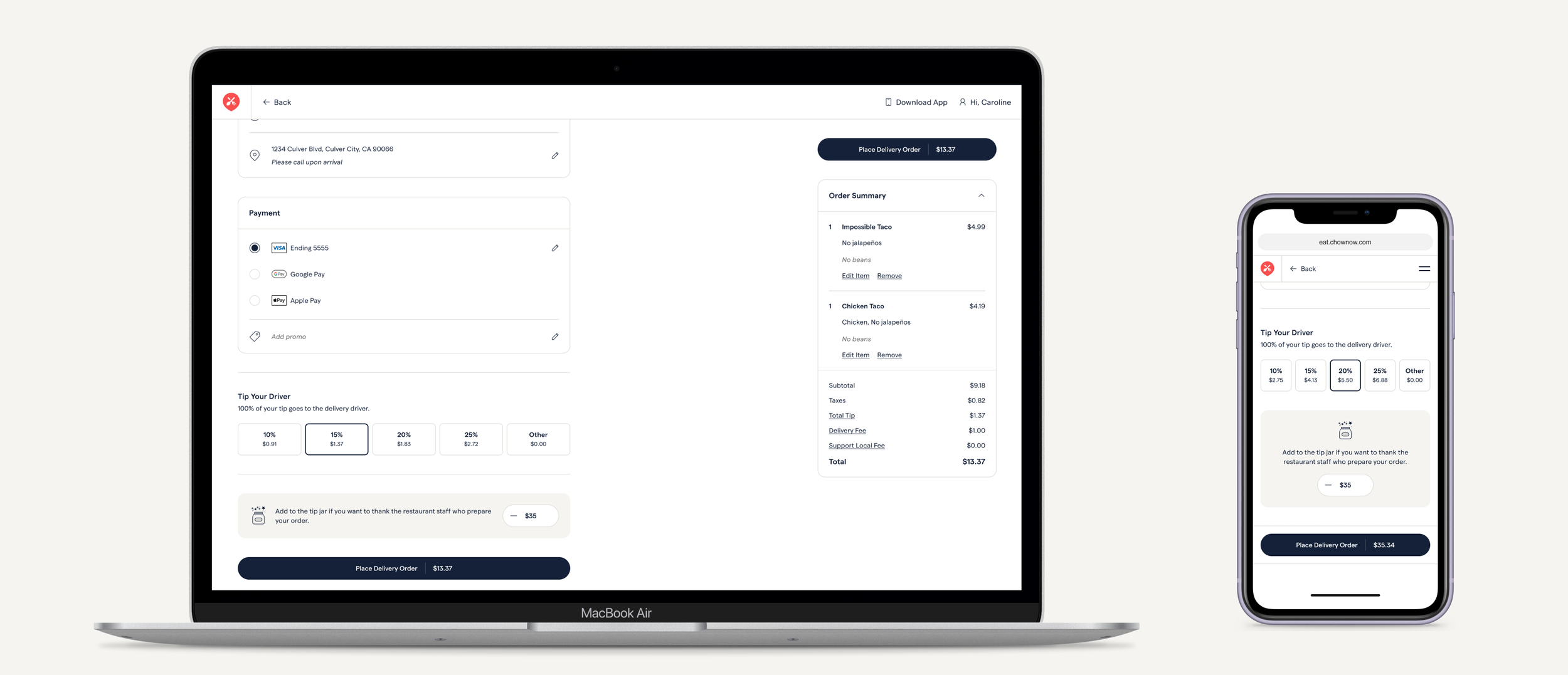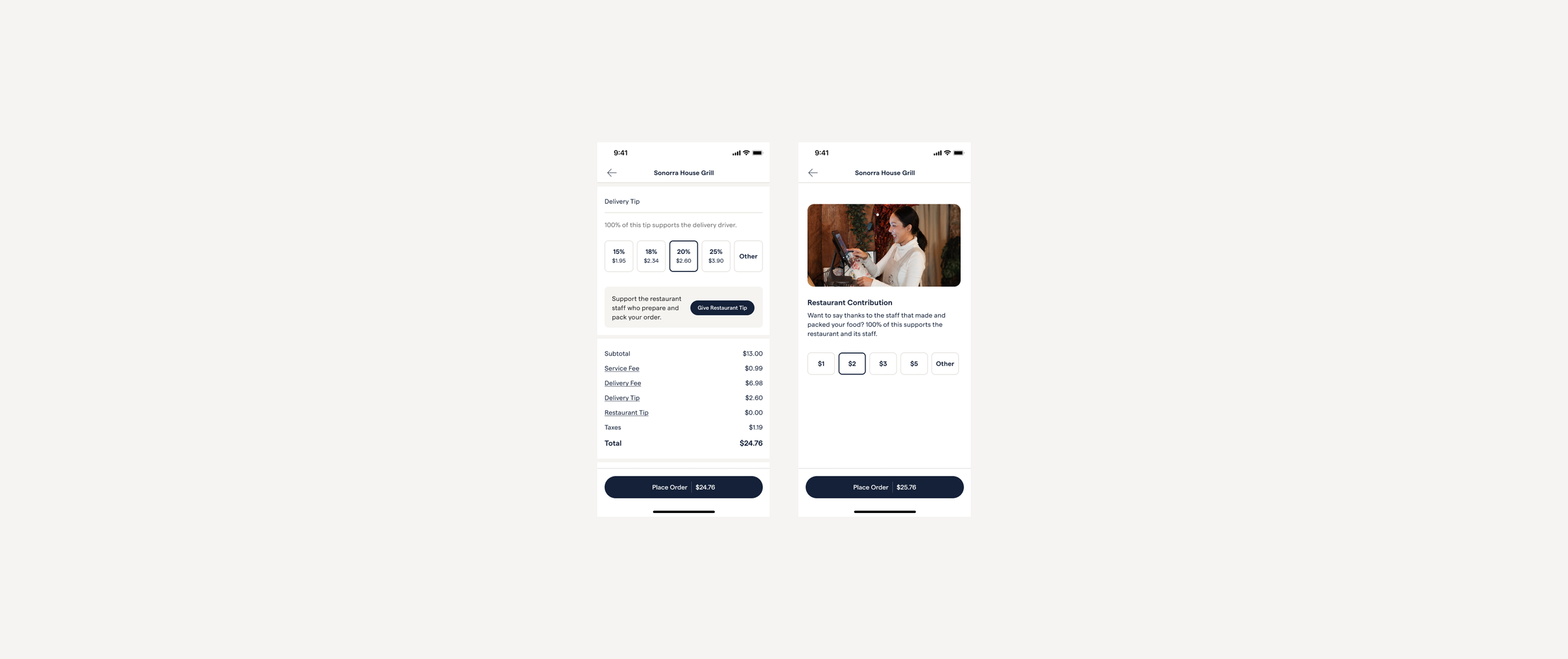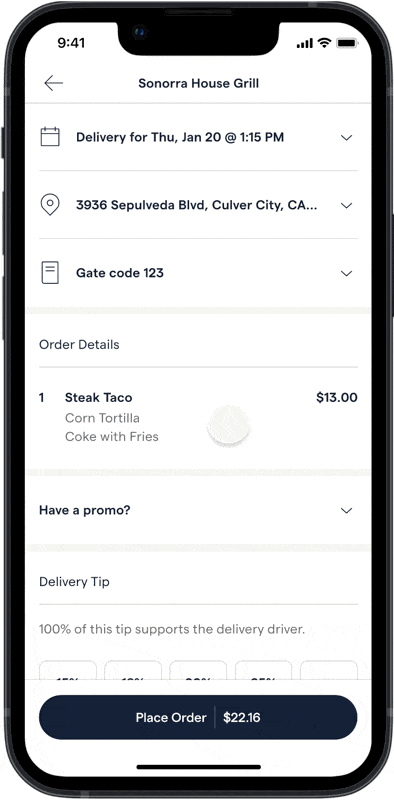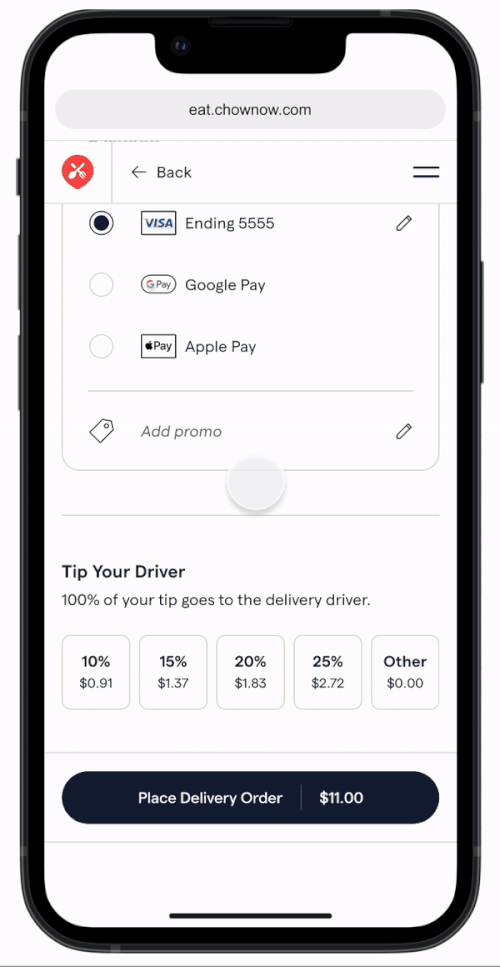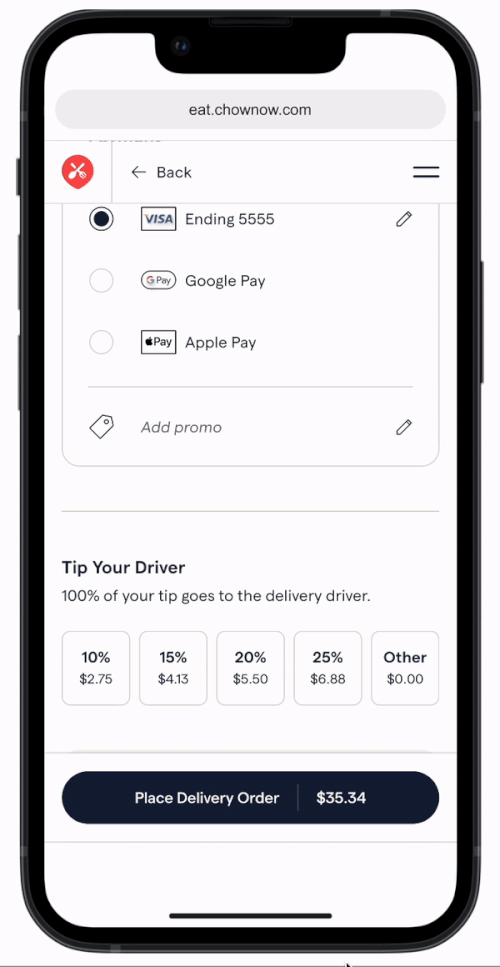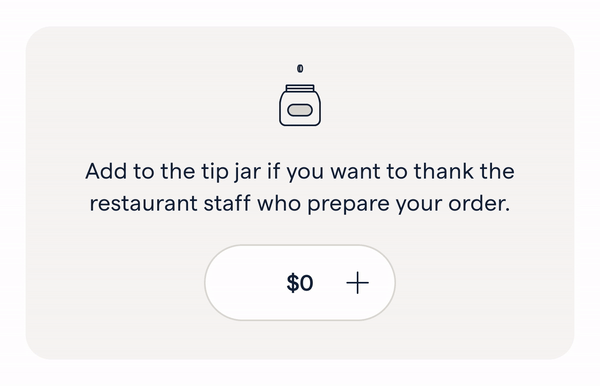Restaurant Tip Jar
Overview
Restaurant servers earn a federal minimum wage of just $2.13 per hour relying on tips to reach livable wages. Yet friction in traditional tipping processes—cash shortages, awkward tablet interactions, and unclear amount suggestions—reduces tip amounts and creates customer anxiety. With 72% of Americans reporting they're asked to tip in more places than five years ago and average restaurant tips at 19.4% optimized digital tipping directly impacts worker livelihood while improving customer satisfaction."
ChowNow is a food ordering company that uses third party delivery services, and can tip a third party driver but not the restaurant. The loss of revenue brings dissatisfaction to many restaurants. By providing a solution for this unmet need, we sought to increase restaurant revenue and retention rate. After creating a competitive analysis, I observed this could be a differentiated feature, also increasing restaurant customer acquisition.
Problem
Goal
Enable restaurants to receive tips on third party delivery orders while not alienating diners due to tipping fatigue and protecting delivery tips.
Project Objective
Learn if users would be willing to tip restaurants on top of tipping for delivery
Understand what type of tip method would garner more tips in a positive manner
Create and explore different design directions and present to the CEO for buy-in and validation
Business Problem
Restaurant staff not getting tips on a delivery can negatively affect employee retention for restaurants
20% of sales prospects have voiced this as an unmet need
Tax discrepancies occur when restaurants create workarounds
Too much tip to the restaurants, can make drivers feel they get a unfairly distributed amount of tips, in the past, delivery drivers have posted on Reddit that “ChowNow steals tips” causing drivers to avoid working with ChowNow
Research
To learn about our company’s currently existing problems, I searched through previous business slack and customer service conversations and followed up with 5 internal stakeholders who have faced issues selling our product or retaining our client due to the lack of this feature
Design
Explorations
One of my key design goals was to make sure that restaurant tips do not take away from driver tips, so I experimented with when the tips showed up in the flow, how prominently they showed up compared to the drivers tip, and which interaction fared the best. After ideating several concepts, I chose 4 prototypes and had 10 users run through all 4 prototypes. In total I did 2 rounds, in order to make updates from insights. I observed for usability, preference, and collected quantitative and qualitative feedback.
V2 - Reduce Noise via Second Page
To reduce noise and to avoid diverting driver, tipping a restaurants occurs via second page.
Learnings:
4.4 user rating
All 10 users missed this button
Although rated high, all users initially scrolled past. Users thought this flow added complexity because it brought them to a new screen.
V3 - Splitting Tips
Would combining tips to delivery driver and the restaurant make users feel less pressured?
Learnings:
4.4 user rating
Most divisive - either users hated it or loved it
Users who loved this interaction loved the idea of paying less overall. Other users found this slider misleading as it calculates a percentage on a percentage. Since we want to make sure drivers don’t get tipped less, this is a more risky approach.
V4 - Simple Select + Rounding the Bill
A simple quick selection that reflects a pick up tip.
Learnings:
4.2 user rating
This was the most straight forward, and many users chose the round up option as they many diners already do this in restaurants.
V1 - Push Notification After a Positive Review
To reduce tip fatigue, should a tipping option only occur after they place an order, and only if a user gives a positive review?
Learnings:
4.9 user rating
Overall flow worked well, but diners confused this as feedback for drivers
Not all users have push notifications turned on, diminishing the value of this feature
Suggested Design
Insights
Product Evolution
Surprisingly, overwhelming amount of user were willing to tip a restaurant on top of a the driver tip. Most users already rounding their bill at a restaurant so most chose to do that in this test. The last design was chosen for this reason.
Kept the dollar amount option for the restaurant to make it feel light weight.
Added a progressive disclosure to bring attention to this section as it is easy to skip over.
Added wording to explain the tasks restaurants did to encourage tipping
Future
I had the opportunity to test this final design with an Italian restaurant owner. He was passionate about this issue because his restaurant is 100% delivery. His preference would to list restaurant tips before driver tips and for the tip to be a percentage, not a dollar. Although his situation did not represent our average restaurant user, but is good to note for future versions of this feature (and for catering situations).
Company Impact
I presented my research and concepts to the CEO and conveyed that this feature would be a positive add for all users involved.
This initial discovery was received positively and this project and specific direction was added to the roadmap.
Design Handoff
6 months passed and this project was approved and picked up by a team with a Product Owner and an Engineer. At that time, I was already working on two other projects so another designer continued the work and I remained as a consultant. I passed on my learnings and recommendations. What the designer found, was a change in user sentiment and so accordingly adjusted the design. She explored different visual treatments with pictures and tested progressive disclosure.
“A lot changed during the six months between the two rounds of testing — diner sentiment around tipping became much more negative, which aligned with overall ChowNow data trends of decreased % of diners tipping and decreased tip amounts.
‘If I'm going to pick up an order from a restaurant, I usually don't tip, I guess in COVID times I did because like, times are tough, but right now, like times are tough for everybody.’ ”
The Tip Jar
The final design was a whimsical approach to lighten the mood as photos provided too much of an emphasis and the progressive disclosure communicated a forced tip. This final design mimics the tip jar at pickup, which feels more light weight and less pressuring.
Impact
The Beta and subsequent A/B tests were so successful that a full rollout of the feature was accelerated
There was no impact on diner conversion or negative impact on Third Party Driver Tips
Average Restaurant Tip: 9% of subtotal
Average Third Party Driver Tip: 15% of subtotal
(compared to 12% for all Third Party Tips)% of Orders that received $0 Third Party Driver Tip: 11%
(compared to 22% for all Third Party Tips)
Animation
After the testing was successful, animation was added for a fun whimsical surprise for diners who added to the tip jar.
The Team
Researcher & Product: Jenny Cheuk
Product: Caroline Muelenaer
Product Manager: Julia Guyadeen
Engineer: JD Wolk
